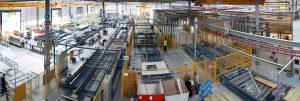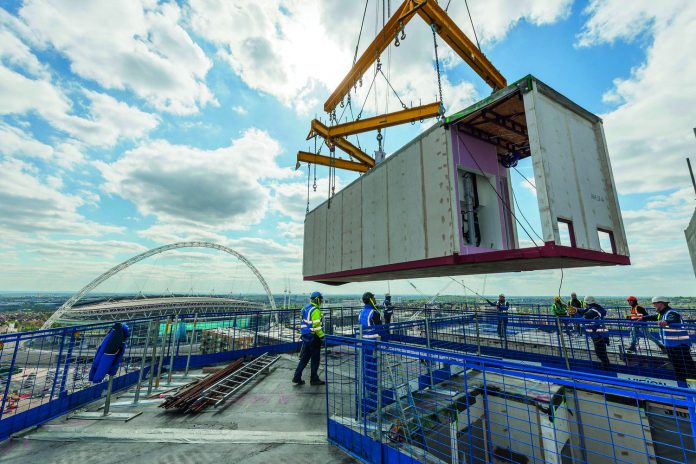With decades of experience to draw on, Cogent Consulting is incredibly busy advising on a wide range of offsite delivery issues across the UK construction sector. Managing director, Darren Richards, shares his perspective on the progression within the sector over the past five years to the present state of this evolving market
While the offsite industry has made significant progress, it is still not considered mainstream by any stretch of the imagination. There is still an abundance of manufacturers in the offsite space that are not embracing digital engineering and design for manufacture and assembly (DfMA) principles at the pace required. The concept of common digital front-end configuration and optimisation software entering our everyday work is quite some way off.
Naturally, there are always exceptions – pioneers and trailblazers – but these companies on their own will not create a big enough impact to bring the offsite manufacturing sector collectively into an industry-leading position. I think that could still be another decade away, but I am determined to see it mainstream in my working lifetime.
Over the past five years or so, the offsite industry has changed significantly. This is mainly down to the numbers of new entrants into the manufacturing space and the consistency of messaging from government – creating both high profile and encouragement for architects and contractors.
I am concerned that many of the new players do not really understand the magnitude of the challenge that our offsite manufacturing industry faces in scaling up and transitioning from “cottage industry” to critical constituent, and we are yet to see many significant successes at scale.
Providing a better built environment
Build back better is the government’s current mantra and with the housing shortfall there has been an emphasis on the residential sector, but offsite technology is adaptable and capable of providing solutions across all vertical markets, from housing to infrastructure and everything in between.
We have seen significant uptake of offsite technology in education and now healthcare – infrastructure has embraced offsite techniques for decades and now with major projects such as Hinkley Point, Heathrow and HS2, we will see even greater innovation and upscaling.
Retail, leisure, hotel and student accommodation sectors have all been huge consumers of offsite technology too and offsite methods are now the norm – not even debated but now assumed. One of my biggest frustrations is the lack of technology migration and knowledge transfer from some of these vertical markets across to housebuilding, so we end up seeing a lot of reinventing the wheel instead of evolving the wheel.
There are a multitude of panelised systems in the offsite portfolio but more recently, hybrid and volumetric modular techniques are grabbing most of the headlines. My view is that this is because people ‘get’ the volumetric modular concept without too much requirement to look under the bonnet.
hey understand the level of completeness and see the process of module installation as being relatively straightforward, whereas understanding panelised approaches requires a much more detailed understanding of the technology and the design coordination and logistic processes involved.
In terms of volume, the number of homes delivered using offsite techniques is still dominated by panelised approaches – timber frame, SIPS and light steel frame – in a magnitude way above those being delivered via volumetric modular approaches. The danger in making comparisons is that you are tempted to play one offsite technology or system off against another, when the real question should be “how much total market share does offsite technology have of the housebuilding sector?”

Entering the offsite arena
Cogent advises many across the construction industry on developing offsite manufacturing businesses at all levels but we do not underestimate the task in hand. Regardless of the technology, a new initiative or manufacturing investment requires deep pockets and specialist skills. Too many new entrants into the sector are “men of straw” attracted because of the obvious groundswell of interest and the theoretical money-making opportunities at hand.
Entering the offsite manufacturing sector requires time, money and resource to be planned accurately and significant contingencies need to be allowed for – especially around areas of testing, validation and certification. Not over-complicating the manufacturing operation from the beginning is crucial to success. The key is to get the offsite system right and then to consider mechanisation and automation once the concept has been embedded.
Making sure that the prototyping and pre-production phases are not short-circuited is another vital element, as these are the most valuable parts of the process. The danger is that you develop a technology that is fantastic in-situ but very difficult to manufacture, or vice versa.
The key is to find a blend that suits the business objectives. This is where DfMA comes into play – the focus should be on “assembly” as there is a massive and indigenous component manufacturing supply chain in the UK, with skills and expertise to support many of the new offsite manufacturing businesses. So there is no point in bringing processing, cold-rolling, laminating, finishing processes in-house when it is often more efficient to tap into the expertise and resources that is offered by the supply chain.
All too often, we see an obsessive approach to “bringing it all in-house” and in many instances, that just serves to create a more complex operating model and a much higher demand on finances to fund all of the Capex required.
The key consideration when entering the offsite arena is experience – engage the best expertise that you can to support you on your offsite manufacturing journey to avoid making the same mistakes as those that have gone before you.
Knowledge sharing and collaboration
In my opinion, those operating in the sector should collaborate for the greater good. The real competitor is traditional construction, not necessarily the next manufacturer down the road. Knowledge sharing and collaboration are key to future success.
The offsite sector has low double-digit market share of the total construction pot, so we have a long way to go before we need offsite manufacturers to directly compete with each other. Yes, there will be tenders and frameworks to compete for, but many in the offsite sector realise that to collectively create a game-changing environment for the industry to prosper then collaboration is key.
The offsite technology trade associations have a significant role to play in facilitating this and many of the new entrants into the offsite manufacturing sector need to be nurtured so as not to unintentionally damage the industry with poor products or system failures. The key is to get the associations to set the entry level high and to help bring new entrants (and some old laggards) up to the minimum acceptable level of operational and quality standards.
The future’s bright, the future’s offsite
As far as the future is concerned, the integration of digital tools is definitely a game-changer but much of this is often seen to be out of reach for many offsite manufacturers, on the basis that there is a requirement to embed and mature much more fundamental operational processes and procedures before getting too carried away with digital tools.
Digital tools are a fantastic means to an end – they permit external architects and engineers to access and work with offsite manufacturing details but often, the fundamentals are missing or inadequate. These fundamentals include a robust approach to Bill of Materials generation, labour time planning and lead time analysis, stock control systems (ERP) and basic production capacity planning tools that are the spine of any well-run manufacturing or assembly operation.
No matter how forward-looking we are in terms of digital tools – BIM, AR/VR, AI, for example – unless we get the fundamentals right it is a futile exercise. The key is to ensure our offsite manufacturing base in the UK is world-class in its adoption of reliable and robust manufacturing operations and repeatable processes, before getting too carried away with the front-end digital tools.
My view is that our industry has a long way to go to get the basics done well and to move away from the “construction” mentality to the “manufacturing and assembly” mentality and culture. If we get the basics right then the adoption and rollout of the more sophisticated digital tools will be much easier and will come at a pace.
As for the next five years, I would envisage lots of mergers and acquisitions, supported by an increasing influx of outside cash as some of the leading offsite manufacturing players begin to show decent financial returns and the venture capitalists and well-heeled private investors begin to see the medium to long-term potential of the sector.
I hope we will see much greater migration of personnel from the automotive and aerospace sectors to the offsite manufacturing sector – bringing with them an abundance of knowledge and skills around world-class manufacturing processes and protocols – this will be the real game-changer for our sector. Whatever happens, I am certain that we face an exciting future and that our industry will continue to flourish.
Darren Richards
Managing director
+44 (0)1743 290010
Twitter: Cogent Offsite
LinkedIn: Cogent Consulting














